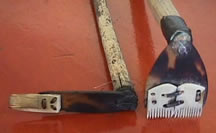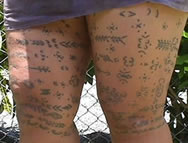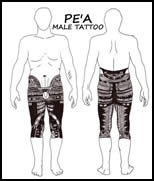
Tattoo Art:
12 Sene: Tattooing Instruments
18 Sene: First Stage of Tattooing
27 Sene: Progressive Stage of Tattooing
1.00 Tala: Tattoo When Completed
There are not many Polynesian words that have entered the English language, but perhaps the most widely used is tattoo. Exactly where and when the word "tattoo" originated is open to debate, but it is certain that it was a corruption of the polynesian word tatau, picked up by the early European sailors exploring the Southern Ocean.
The presence of "britches" upon Samoan males, was commented upon in many ships logs of the early explorers, and were sketched by many of the artists that were taken along on these voyages of discovery. Where the Samoans aquired this skill is not known, but there is a folk tale that explains that it was brought to Samoa by two Fijian women. Unfortunately during the course of their journey they made a mistake in the song they were singing. Rather than singing "Tattoo the women and not the men" they started singing "Tattoo the men and not the women". When they arrived in Samoa the first few villages they arrived at were not interested in their skill, but eventually a chief recognised their artistic abilities and they taught the villages their trade and showed them how to make the tools they needed.
There is another story which explains that originally tattoos were painted upon the skin, but a Samoan adventurer who travelled to the kingdom of the spirits learnt the art of true tattooing. He was treated very well by its inhabitants but they found his painted body decorations a pale immitation of their own tatoos. He learnt the art of tattooing, and when he returned to Samoa he introduced the use of hammers and sharpened bone or teeth for tattooing.
Traditional Samoan tattooing of the pe'a, body tattoo, is an ordeal that is not lightly undergone. It takes many weeks to complete, is very painful and used to be a necessary prerequisite to receiving a matai title; this however is no longer the case. Tattooing was also a very costly procedure, the tattooer receiving in the region of 700 fine mats as payment. It was not uncommon for half a dozen boys to be tattooed at the same time, requiring the services of four or more tattooers. It was not just the men who received tattoos, but the women too, although their designs are of a much lighter nature, resembling a filigree rather than having the large areas of solid dye which are frequently seen in mens tattoos. Nor was the tattooing of women as ritualised as that of them men
The whole process was highly ritualised with songs to be sung and tabus being placed on those that were undergoing the ordeal. Some of the first European visitors to Samoa commented upon the tattoos being of religious significance but this seems to have been disputed by anthropologists (both professional and amateur) who arrived later. It is interesting to note that most of the motifs of animal origin are animals which were considered to be sacred by different families.
The Samoan tattooing instruments I acquired in Apia are almost identical to the same tools I've studied at the Suva Museum in Fiji, which lends credence to the legend of the women bringing the art across the ocean to Samoa. I say almost, because the Fijians preferred to use human bone for the construction of the teeth on the striker; the Samoans usually used boar tusk. The ancient Fijians did love their human flesh as is evidenced by the specialty forks and platters reserved for the human feast and the human bones stuck in the forks of trees after dinner.
The instruments of the tufuga, the so-called au, resemble hoes but are of varying width. The comb-like serrated part of it, which comes into contact with the human skin, is always made of bone. The preferred materials for this purpose are human bones but if there are none available, horse or ox bones are used.
The toothed part of the implement which pierces the human skin is connected to the actual handle by a toe which usually consists of tortoise-shell and sometimes of bone. The handle is made of cane or wood. The parts of the implement are tied together with cocoanut fiber. The bone and tortoise-shell parts in drilled in various places. A complete set of tattooing instruments consists of eight to twelve implements, depending on the artist.
A short wooden mallet is used for the insertion of the instruments into the skin.
The Samoans tattooed the nose as a punishment for a serious crime and it was equal to having an ear cut off.
The Samoan tattoo is called a pea’a on the men and a malu on the women. The pea’as encompassed the entire area from above the waist to below the knee, and were usually done in one go, taking perhaps a week or two. The teeth of the hoe-like striking instrument were carved longitudinally from the incisors of the wild boar, which in turn was affixed to a piece of turtle shell. The teeth were sharpened with a piece of coral, and if not kept sharp will cause a lot of tissue damage. I have witnessed a fair amount of scarring in Samoan tattoos but some of the areas they tattoo! Behind the knee! Inside the crack of the butt cheeks! No wonder! Before the advent of antibiotics in the 1940’s there was an alarming rate of infection, some actually leading to the death of the tattooed, fortunately that is no longer a problem.
Europeans first saw the Samoan Islands in 1722. The first Europeans who set foot on Samoan soil were members of a 1787 French expedition who had a close look at natives and reported that "the men have their thighs painted or tattooed in such a way that one would think them clothes, although they were almost naked."
When missionaries arrived, tattooing was one of the customs that they tried to suppress. One missionary wrote: "Tattooing is among the works of darkness and is abandoned wherever Christianity is received." The Samoans saw Christianity as something they could add to their culture, not as something to replace it. For young Samoan men, tattooing was a rite of passage from boyhood to maturity. A young man who was not tattooed was considered still to be a boy. He could not marry; he could not speak in the presence of grown men; and he was obliged to perform menial tasks. The fact that he sometimes attended Sunday services held by missionaries was no reason to give up tattooing!
Tattooing in Samoa was never abandoned as it had been in many other Polynesian lands. The act of tattooing is highly respected in Samoa.
Stages of Tattooing
In theory it should be possible to complete a pe'a in 10 days; 5 sessions with a day in between each to let the inflamation subside, and on the tenth day, the removal of the taboo which has been placed on the person being tattooed. However this is never the case because the pain and the damage to the skin is too great. The five stages are well defined and outlined below.

I. O le Taga Tapulu (back and small of the back)
In the first session the height to which the tattoo will rise is decided (Ano le Tua), this is always such that the top of the design will show above the lavalava. Then the va'a, pula tama and pula tele are outlined and the design filled in.
The aso fa'aifo run all the way round from the back to the groin and the ivitu runs down between the buttocks to the anus.

II. O le Taga Fai'aso (the posterior)
The aso fa'aifo are completed around to the abdomen and the 'asolaititi are finished. Next to be added are the saemutu, which vary in number depending upon social status. A matai will have four an orator three and anyone else would have two. It appears that this distinction is not strictly adhered to today. Below the saemutu it is possible to find a wide range of devices, although traditionally there were meant to be two thin lines 'aso e lua. Beneath these another band the 'aso taliitu is added, which goes all around the top of the thigh. Where it meets the 'ivimutu at the anus it is called tafaufile, where it covers the perineum it is called tasele, where it covers the scrotum it is called tafumiti and the area over the penis is called tafito. Needless to say this is very painful.
III. Taga Tapau
The lausae, an area of solid tattooing, is added to the thighs beneath the aso e lua.
IV. Taga o Fusi ma Ulumanu
The fourth session is the tatooing of the ulumanu, from the center of the thigh up to the inner groin. In addition the fusi is added, this being a ribbon extending from the perineum and widening to the width of a hand behind the knees.

V. 'Umaga (the end)
The final sessions invloves the tatooing of the abdomen and the navel, the area that covers the navel being called the pute, and is apparently the most painful part of the whole process.
During the who of the process the tattooer, tufuga is assisted by upto six helpers all of whom wish to become masters themselves. One will be responsible for the mixing of the dyes, another is responsible for wiping away the blood, another for dipping the instruments into the dye and receiving instruments that have been used, another cleans and sharpens the teeth of the combs and another will hold the skin tight.
Young women would sit around the person being tattoo, holding them down to stop them moving to much and thus damaging the tattoo, and massaging the head. In addition they will sing a song to try and keep him occupied and keep his mind from the pain in case he starts to complain or cry, which was considered disgraceful behaviour and unfitting for a man.
Below is a song sung repeatedly by women to the men being tattooed.
That is not the pain of a sick person.
That is the pain of a novice!
Relax your body like giving up,
Give in, o chief!
Chorus:Ah, you suffer beneath the blows,
Ah, till you fall asleep,
And you are not tired nor weary of it!
Soon you will receive your pretty chains of adornment
As yet they are seperate and not joined;
The necklace is still in pieces and not quite finished.
Give in, o chief!
But soon in the evening
You will look at your tattoo
Comparable to a fresh ti leaf.
Give in, o chief!
Ah, if it were a burden
I would carry it for you in my love.
O be quiet and give in,
I will withdraw when the blows have fallen
Give in, o chief!
The stylet and the hammer strike,
The colour is applied so that it may adhere.
Give in, o chief!
Like water flows your blood,
Ah, I feel pity for your condition.
Give in, o chief!
But this is the custom ages old,
You constantly moan, but I sing.
Women must bear children,
Men must be tattooed.
And the tattooer will be struck by the trade wind.
Give in, o chief!
The necklace may break, the string may break
But you tattoo will not break.
This necklace of yours is permanent
And will go into the grave with you
Give in, o chief!
 | I. Togitogi (dots) These are normally found in the tattoos on womens hands. II. Aso (thin cross beam) This is normally used when tattooing a man's back. III. Fa'avaetuli (like the leg of a golden plover) These are normally used in womens tattoos. IV. Fa'aanufe (worm-like) Generally used in womens tattoos V. Fa'alaupaoga (like the leaves of a Pandanus tree) VI., VII. Aso Fa'avaetuli (like the leg of a golden plover) VIII., IX. Atualoa Used when tattooing the front of mens legs. X. Fa'amuli'ali'ao XI. Fa'a'upega (net-like) Used in men around the groin. XII. Aso Fa'avaetuli (like the leg of a golden plover) XIII. Aveau (starfish) Used when tattooing women. |







3 comments:
very good posting. i liked it. :-)
bathmate
Hi, it's very interesting !!!
I'm french guy with origins of Wallis & Futuna (near Samoa).
SO i'm very attracted by Samoans tattoos, and i really want to know, to understand all about sense, meanings of patterns, choice of body location, etc ...
Can you tell me more about ?
Thanks for all your post !
Tattoo is now very trendy fashion in today’s fashion world as well as in common people. Young generation likes Samoan Tattoo too much. Thanks a lot to tell us about Samoan Tattoo.
Post a Comment